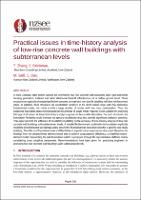| dc.contributor.author | Zhang, Tongyue | |
| dc.contributor.author | Seifi, Mehrdad | |
| dc.contributor.author | Brinkman, Stephen | |
| dc.contributor.author | Das, Sam | |
| dc.date.accessioned | 2024-07-01T02:01:10Z | |
| dc.date.available | 2024-07-01T02:01:10Z | |
| dc.date.issued | 2024-04-09 | |
| dc.identifier.uri | https://repo.nzsee.org.nz/xmlui/handle/nzsee/2691 | |
| dc.description.abstract | In New Zealand, older power stations are commonly low-rise concrete wall structures with rigid basements housing generators, turbines and other electro-mechanical infrastructure at or below ground level. These structures are typically characterised by low concrete strength and non-ductile detailing with low reinforcement ratios. In addition, these structures are acceleration sensitive in the short period range with few distinctive fundamental modes, but rather exhibit a large number of modes with low mass participation. Thus, the traditional equivalent static method based on the premise of single mode response is not suitable for analysing this type of structure. A linear time-history analysis appears to be a viable alternative. For such structures, the foundation flexibility could increase the spectral acceleration but also provide significant radiation damping. This paper presents the influence of foundation modelling on the accuracy of time-history analysis of low-rise concrete wall buildings with subterranean levels. A detailed finite element model with the foundation explicitly modelled and distributed soil springs acting around the foundation has been developed for a specific case study building. The effects of foundation mass and flexibility on superstructure response are discussed. Based on the findings from the detailed finite element model and to achieve computational efficiency, a simplified macro-element model representing the soil-foundation system is proposed through the representative stiffness matrix considering cross coupling components. Recommendations have been given for practicing engineers in analysing low-rise concrete wall buildings with subterranean levels. | |
| dc.language.iso | en | |
| dc.publisher | New Zealand Society for Earthquake Engineering | |
| dc.relation.ispartofseries | 2024;136 | |
| dc.subject | Seismic performance, risk mitigation and resilience of new and existing structures | |
| dc.title | Practical issues in time-history analysis of low-rise concrete wall buildings with subterranean levels | |
| dc.type | Article | |

